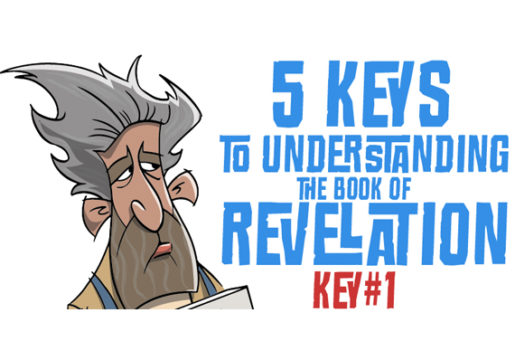
KEY#2: INTERPRET THE BOOK OF REVELATION LITERALLY
The Book of Revelation can be intimidating and unfamiliar even for Christians if they haven’t had the opportunity to study it. As Dr. Henry Morris and other prophecy experts have said, “The book of Revelation is not hard to understand. It’s just hard to believe.” If we believe the first verse of the Bible, than approaching the book of Revelation with that same mindset of belief sets us on a path to discover truth about the things to come.
This series of posts will unpack five keys that will help remove the intimidation factor and help people get excited about studying the Book of Revelation. After all, it is “the Revelation of Jesus Christ” (1:1) and includes a blessing (1:3) to anyone who reads or hears the “words of this prophecy”. Revelation 19:10 even tells us that “…the essence of prophecy is to give a clear witness for Jesus.” Jesus was the ultimate prophet and the book of Revelation is all about His future return to set everything straight. Well worth the time to study this amazing book of the Bible. Here is Key #1!
KEY#1: START WITH THE BOOK OF DANIEL
Daniel is the “Revelation” of the Old Testament so to speak. It details Daniel’s captivity in Babylon and how He and other Jewish captives adjusted to living in a completely pagan culture. Daniel was a bright light in a dark place. Most are familiar with the story of Daniel in the lion’s den and the account of the fiery furnace faced by three of his friends. The narrative of the book of Daniel gives us insight into how to live in an increasingly pagan culture in our day. Most Christians are familiar with those stories from the book of Daniel but many are surprised to learn that a full 1/2 of the book of Daniel is consists of very detailed prophecies given to Daniel which predict major historical events from just after Daniel’s time all the way through the future tribulation period.
Daniel’s visions establish the basic framework for end-time events and John’s Book of Revelation adds more detail and ties up all of the loose ends. Revelation is where all the Old Testament lines of prophecy converge, but a good understanding of the initial framework set forth in Daniel is critical. John’s immediate audience would have been people familiar with the book of Daniel. References and symbolism used in Revelation are understood when viewing them through he lens of Daniel. John assumes his readers had knowledge of the book of Daniel. Think of it like this. If the book of Daniel is viewed as the foundation and frame of a house, then Revelation the drywall and finishing. We don’t know the specific details of all of the fixtures, paint colors, and tile choices, but we know enough from these two books (and other Biblical passages) to understand the key events, players, and the basic chronology…so much so that we can clearly see the stage being set in our day for these end time events.
Daniel chapter 2 provides the basic framework. Then Daniel chapters 7-9, 11, 12 give us more of the key details. Daniel chapter 9 in particular (the 70 “weeks” of years) points to 69 “weeks” of years that begin with the command to rebuild Jerusalem (command by Artaxerxes in 457BC, Ezra 7:12-26) and end with the “Messiah the Prince” entering Jerusalem (Palm Sunday) 490 years years later. This prophecy was literally fulfilled, some experts even say it was fulfilled not just to the year but to the exact day. Next, Daniel chapter 9 tells us that the messiah is “cut off, but not for himself.” This was strange and cryptic language until the cross. Now we understand this was a reference to Jesus’ sacrificial death on the cross to save us from our sins.
After 69 “weeks” (of years) we notice an indefinite period of time exists before the final “week” of 7 years. Logic necessitates this mysterious gap (what we now know as the Church Age/Age of Grace) before the future 7 year tribulation period. The reason logic demands a gap is because verse 26 tells us that the temple will be destroyed (this was literally fulfilled in 70AD by the Romans), but then in verse 27 it says another future ruler will “put an end to sacrifices”. This necessitates the rebuilding of an end-time temple (currently in development by The Temple Institute of Jerusalem). So, somewhere between 70AD and the final week of 7 years, another temple has to be built. This gap is where the mystery of the Church age was hidden in the Old Testament and revealed in the New Testament. Revelation gives us more detail indicating the new temple must be rebuilt by the middle of the tribulation period.
An understanding of these six chapters from the book of Daniel will help make the book of Revelation much easier to understand for the student of prophecy. The books of Daniel and Revelation work in tandem and help us understand the key end-time players, events, and conditions.
Up next is KEY#2: INTERPRET THE BOOK OF REVELATION LITERALLY
RESOURCES FOR FURTHER STUDY
Here are a few GREAT books to get if you would like to dig deeper.
Agents of Babylon: What the Prophecies of Daniel Tell Us about the End of Days (Jeremiah)
40 Days Through Daniel: Revealing God’s Plan for the Future (Rhodes)
40 Days Through Revelation: Uncovering the Mystery of the End Times (Rhodes)
Charting the End Times: A Visual Guide to Understanding Bible Prophecy (LaHaye/Ice)
Every Prophecy of the Bible: Clear Explanations for Uncertain Times (Walvoord)
